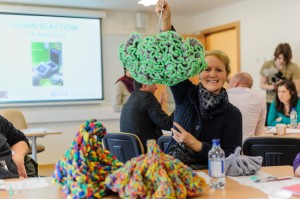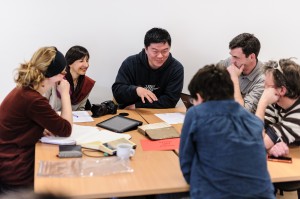The second workshop of the Chain Reaction! project took place on 18 April 2013. We spent the day in the nice new Colyer-Fergusson Music building at the University of Kent, a fittingly creative space in which to have artists discussing their practice. The workshop was thoughtfully planned and run by Caterina Albano of Artakt and Central St Martins College.
The main objective of the workshop was to enable artists to present their projects and move their work forward through exchanging with other participants in the project and with scientists. Overall, this objective seems to have been met. Several artists declared at the end of the day that they felt much clearer about their project in particular and Chain Reaction! in general. So, what went on in the room?

Whitstable-based artist Annie Halliday displaying some of the work created as part of the Chain Reaction! project.
The first session of the day was devoted to having each one of the six artists presenting their project for Chain Reaction! in relation to their artistic approach. These short talks all brought evidence that each artist had engaged in a reflective process in order to come to grip with the body of knowledge associated with the PCR machine – genetics, and molecular biology in general – so as to be able to translate it into a work of art. Words such as copying, repetition, mutation, enzymes, all relating to the specialised knowledge the machine is used to produce, often came up in this session. By contrast such notions as pipetting, designing experiments, interacting with the machine, troubleshooting, the idiom of practical, material laboratory life remained largely unspoken.
This contrast points towards one essential feature of such scientific tools as the PCR machine: they are good at constraining people’s actions and thoughts. These tools are kernels around which congregate scientists sharing common beliefs about how the natural world works and appropriate and desirable ways of producing knowledge about it. One such belief, for instance, is that in order to produce objective knowledge, the human subject has to be erased from accounts of the way knowledge was obtained. Laboratory tools are disciplinary devices. Engaging with them implies sharing into these beliefs, adopting for oneself the disciplinary identity that goes with them. People are disciplined by laboratory tools.
Escaping their disciplinary power, engaging with them without adopting the beliefs associated with them, is difficult. Yet, it is necessary if one is to maintain the distance that will allow one to pay attention to the myriad of practices surrounding these instruments which participants in the discipline take for granted, and forget about, making them disappear from their final accounts of the way they produce knowledge.
Yet, and at the same time, it is difficult to make sense of a PCR machine, to understand how it works, what it is used to do, without at least a passing understanding of the theoretical knowledge it relates to (genetics, DNA…). But this may be the tree that hides the forest. In this case, though, would such “objective” knowledge not be a camouflage for the subjects who produced it?
However, aside from emphasising the challenges posed by engaging with laboratory tools, this first session showed the extent to which artists work in ways that are quite similar to that of scientists. In both cases, it is a search process, a journey of discovery, that primarily involves solutions to practical, material problems. Crucial questions in this quest being “can I do it?”, “How can I do it?”, “What should I use to do it?”, and so forth. This proximity between artists and scientists suggests that with Chain Reaction! we are on fertile ground, for artists are well placed to enter into a dialogue with the latter about activities where things, through their resistance to human intervention and the challenges they pose, exert a constraint on human actors, making it necessary to find new ways of obtaining answers to their questions.
This was essentially the topic of discussion of one of the small groups during the second session. Their discussion centred on the constraints that tools and equipment impose on the research process, and in turn how the concept one wants to explore will determine the materials that will be used in the process. This brought up the notion that paying attention to materials allows to revisiting the processes and understanding them. Another group, working with the notion of assemblage remained focused on genes and molecular biology and came up with the idea that genes having been shaped both by individual factors and environmental pressure are a sort of assemblage of their own. Finally, the third table discussed the theme of rituals and did so in relation to the theme of serendipity. Rituals were defined as ways to keep serendipity in check, ensuring that “creative accidents” would only occur in predictable parts of the experiment, thus allowing the experimenter to make sense of variability, and control the various parameters of the experiment.
These themes were taken up again in the closing plenary session. Then, evoking the similarities and differences between the scientific endeavour and the artistic one that came up during the discussion, the workshop facilitator suggested that both could serve as basis for initiating a productive dialogue between artists and scientist. The question is then how to convey the richness of this dialogue, hence of the Chain Reaction! project? This would be precisely the role of the exhibition that will take place at the end of the year. And it will be the curator’s job to convey it.
Bringing the exhibition to the fore as a key component of the project is one of the main outcome of the workshop. Another one is the demonstration it provided that artists and scientists share common ground. Their practices, in both cases, are materially based and sustained. Their creativity originates from having to physically engage with tools, and matter, and from finding ways around the constraints and obstacles posed by things.
Dr Jean-Baptiste Gouyon, project manager Feb-Apr 2013.



Recent Comments